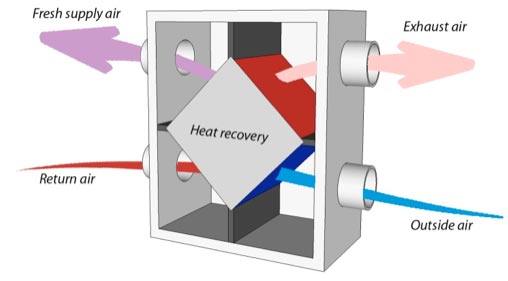Cost Savings of HRV for Homeowners
Just How Heat Recovery Ventilation Enhances Indoor Air Top Quality and Reduces Energy Expenses
Heat Recovery Ventilation (HRV) systems play a necessary function in improving interior air quality while at the same time lowering energy costs. By successfully exchanging stagnant interior air with fresh outdoor air, HRVs aid keep ideal humidity and lower toxins. Furthermore, their ability to recover warm from outbound air lessens the stress on home heating and cooling down systems. As energy prices continue to rise, recognizing the full possibility of HRV systems ends up being increasingly vital for property owners and organizations alike.
Understanding Heat Recovery Ventilation Solutions

Heat recovery ventilation (HRV) systems play a crucial role in enhancing interior air quality, particularly in modern, energy-efficient buildings. These systems are made to transfer heat from the outbound stagnant air to the inbound fresh air, therefore minimizing energy loss while maintaining optimal temperature level degrees indoors. HRVs consist of a heat exchanger, followers, and ductwork, facilitating the continuous circulation of air. By removing indoor pollutants and introducing fresh air, HRVs help to balance humidity levels, prevent mold growth, and lower allergens. The performance of HRV systems depends on their capacity to recuperate up to 80% of the warmth from the tired air, advertising power preservation while guaranteeing a healthy indoor setting. Their combination is crucial in accomplishing sustainable living practices.
The Significance of Indoor Air Quality
Indoor air quality (IAQ) is a crucial factor affecting the wellness and wellness of residents in any setting. Poor IAQ can result in various wellness concerns, consisting of breathing problems, allergic reactions, and tiredness. Additionally, it can worsen status quo such as bronchial asthma. Aspects adding to reduced IAQ consist of pollutants from interior resources like cleaning agents, mold and mildew, and inadequate ventilation. Consequently, maintaining good IAQ is vital for promoting a safe and comfy living or functioning room. Effective approaches to improve IAQ involve normal surveillance of air quality, correct air flow systems, and minimizing the use of hazardous compounds inside your home. By focusing on IAQ, individuals can ensure a healthier atmosphere that promotes performance and overall quality of life.
Power Effectiveness Perks of HRV Systems
Lots of home owners and building managers are progressively acknowledging the energy performance advantages of heat recovery ventilation (HRV) systems. By transferring heat from tired indoor air to incoming fresh air, HRV systems substantially lower the power required for home heating and air conditioning. This procedure decreases reliance on typical a/c systems, resulting in reduced power bills. Furthermore, HRVs assist maintain a well balanced interior climate, avoiding too much heating or cooling down needs. The capacity to recover as much as 90% of the warm from outward bound air also sustains sustainability initiatives by minimizing general energy intake. Subsequently, More Info HRV systems add not only to set you back financial savings however also to a reduced carbon impact, lining up with the growing focus on energy-efficient building practices.
Installment and Maintenance Considerations
The reliable application of heat recuperation ventilation (HRV) systems calls for mindful consideration of installment and maintenance variables to ensure peak efficiency. Appropriate positioning of the HRV device is necessary, as it ought to be mounted in a place that takes full advantage of airflow while minimizing noise disturbance. In addition, ductwork should be suitably sized and insulated to stop energy loss. Regular upkeep, including filter replacement and system cleansing, is crucial to safeguard optimal official source performance and interior air top quality. Owners must develop a regular maintenance timetable to identify and deal with prospective concerns before they intensify. Partnership with seasoned professionals throughout both installation and upkeep stages can enhance the long life and effectiveness of HRV systems, eventually causing much better indoor settings and lowered power costs.
Real-World Applications and Success Stories
Discovering real-world applications of warm healing ventilation (HRV) systems reveals their considerable influence on indoor air top quality and energy effectiveness throughout different setups. In property structures, homeowners have actually reported better air quality, leading to less allergic reactions and respiratory system concerns. Schools executing HRV systems have actually kept in mind enhanced student concentration and decreased absence as a result of better air flow. Business buildings, such as offices and retail areas, have actually experienced reduced power expenses and enhanced employee productivity. For circumstances, a company workplace in a warm climate accomplished a 30% decrease in energy bills after installing an HRV system. These success stories demonstrate that HRV innovation not just adds to much healthier atmospheres yet likewise provides tangible economic advantages, making it a valuable investment for various industries.
Often Asked Questions
Can HRV Solutions Reduce Allergens in Indoor Air?
The effectiveness of HRV systems in lowering interior allergens largely depends upon their capacity to filter and exchange air. HRV Heat Recovery Ventilation. By constantly replacing stale air, these systems can significantly reduce allergen degrees throughout indoor atmospheres

How Does Moisture Affect HRV System Efficiency?
Humidity greatly affects HRV system performance; high levels can bring about condensation, minimizing effectiveness, while low humidity may enhance air exchange. Balancing humidity is necessary for excellent procedure and preserving next page indoor air top quality.
Are HRV Solutions Noisy Throughout Operation?
HRV systems can produce differing noise degrees during operation, relying on their style and installation. Some systems operate quietly, while others might produce noticeable noise, especially at greater airflow settings or when inadequately preserved.
What Is the Ordinary Life Expectancy of an HRV System?

Can HRV Solutions Be Used in All Environments?
HRV systems can be utilized in numerous climates, however their effectiveness might differ - HRV Heat Recovery Ventilation. In extreme temperature levels, modifications or supplementary systems may be needed to guarantee suitable performance and convenience while maintaining interior air quality